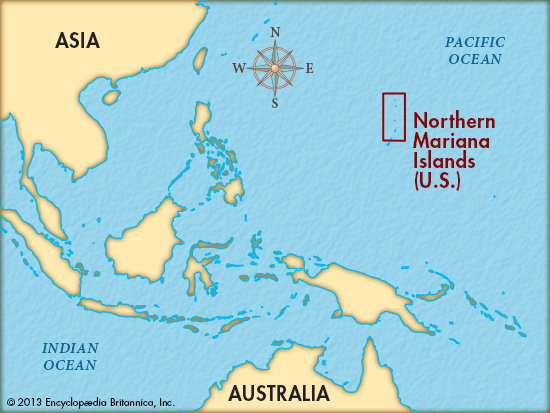Northern Mariana Islands
A COMMONWEALTH IN political union with the UNITED STATES, the Northern Mariana Islands (or CNMI) consists of a string of fourteen volcanic and limestone islands in the far western PACIFIC OCEAN. The islands have closer ties to American and European culture than most others in the region and have therefore opted to retain political and economic integration with the United States rather than seek the free association status of its neighbors.
The Marianas form a segment of a chain of volcanic islands that stretch north from eastern INDONESIA to JAPAN, following alongside a deep ocean trench (the Mariana Trench, which includes the deepest points on the planet) along the edges of the Philippine and Pacific tectonic plates. The three larger islands at the southern end of the chain (Saipan, Tinian and Rota) have 99 percent of the population (86 percent on Saipan), and most of the economic activity. They are volcanic in origin but older than the more recently formed islands to the north and have had longer to form fertile soil through erosion. The small northern islands are thus much taller and steeper (Agrihan is the highest point in all of MICRONESIA) and continue to see volcanic activity: Farallon de Pajaros, Asuncion, Pagan, and Guguan have all erupted in the 20th century, Pagan most recently in 1981, forcing the evacuation of its small population, and Agrihan continually erupting since May 2003. These northern islands have little soil and insufficient rain so have little population.

The island of GUAM is the southernmost island of the Mariana chain but has been administered separately since it passed from Spanish rule to U.S. jurisdiction in 1898. The Northern Marianas were also governed by the Spanish, starting in the mid-16th century, but were sold to GERMANY in 1898, and annexed by Japan in 1914, before finally joining Guam under U.S. administration as part of the United Nations Trust Territory of the Pacific in 1947. The main island, Saipan, served as headquarters for the entire Trust Territory from 1962, while the neighboring island of Tinian was an important Central Intelligence Agency training base for Nationalist Chinese troops. The third major island is Rota. A covenant establishing the islands as a commonwealth with full internal autonomy plus U.S. citizenship was developed in the 1970s and went into effect in 1986.
The local economy benefits significantly from U.S. financial assistance, but is beginning to establish itself independently through tourism, mostly from JAPAN—Saipan is 5,625 mi (9,073 km) from San Francisco, CALIFORNIA, but only 1,272 mi (2,052 km) from TOKYO, Japan.
The tourist industry now employs 50 percent of the workforce and accounts for about half of the total gross domestic product. This, and the emerging garment industry has attracted heavy immigration from CHINA and the PHILIPPINES. Total population figures have risen from just under 17,000 in 1980 to over 80,000 today. Non-U.S. citizens make up about half the population, with Filipinos alone forming roughly a third of the population, but figures are shaky because of illegal migration, and the local native Chamorro people are increasingly dissatisfied with being a minority in their own territory.